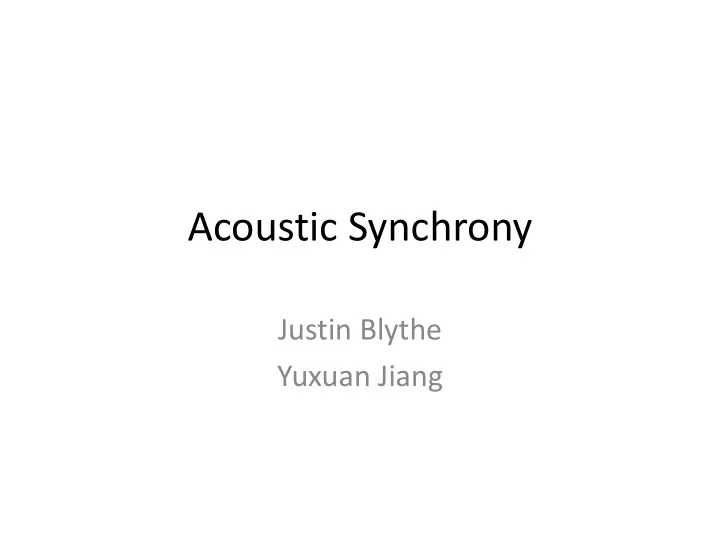

Acoustic Synchrony Justin Blythe Yuxuan Jiang
Introduction • Do crickets synchronize their chirps with neighboring crickets? • A field study by Thomas J. Walker in 1969 found that they do, but under certain conditions. • Walker took recordings of actual crickets, and played them back them to discover if a neighboring cricket would alter it’s chirp rhythm to synchronize. • He found that that neighboring crickets would synchronize their chirp, but not the number of pulses it chirps. • We set out to reproduce these results with a simple microphone and speaking coupling.
Our Two Crickets
Experimental Setup Supplies for each cricket: 1. USB soundcard 2. Microphone 3. Speaker 4. MATLAB window
Experimental Setup • We wrote a MATLAB function that was able to communicate with the soundcard that had a speaker and microphone attached to it. • Using a state variable, discussed previously, we would integrate the equation using a Runge-Kutta fourth order ODE solver (probably a bit much but I already had one). • The microphone would record short instances in time and if it recorded anything louder than a certain threshold variable, which we set, it would add 𝜃 to the current state variable. • Once the state variable reached one, it played a chirp. While playing a would could listen to it’s neighbor and we toggled the ability for listening to itself.
Experimental Setup Integrate State with RK4 𝑦 𝑗 (𝑢) + 𝜃 if( 𝑦 𝑗 >= 1) Record Data
A Model for Pulse-Coupled Oscillators Initially, we started with a model by Steven Strogatz. Given by, 𝜖𝑦 𝑗 𝜖𝑢 = 𝜕 0 − 𝛿𝑦 𝑗 where the state 𝑦 𝑗 ∈ 0,1 , 𝜕 0 is the natural frequency, and 𝛿 is a dissipative term. The correction condition for phase shift is 𝑦 𝑗 = 1 ⇒ 𝑦 𝑘 𝑢 + = 𝑦 𝑘 𝑢 + 𝜃 where 𝜃 is the coupling strength of the cricket and its neighbor.
Strogatz Model • 𝛿 = 0.05 • 𝜃 = 0.3 • 𝜕 0𝑀 = 12.01 • 𝜕 0𝐺 = 11.98
Strogatz Model • 𝛿 = 0.05 • 𝜃 = 0.7 • 𝜕 0𝑀 = 12.01 • 𝜕 0𝐺 = 11.98
A Modified Model To simplify the model we neglected the dissipative term. 𝜖𝑦 𝑗 𝜖𝑢 = 𝜕 0 + 𝜂(𝑢) where 𝜂(𝑢) is the external noise, which we took to be the mean of the recorded data.
Plots of Data with parameter values: 𝜕 0𝑀 = 12.01 𝜕 0𝐺 = 11.98 𝛿 = 0
Synchrony
Synchrony
Shifts by 180 °
Shifts by 180 °
Simulation Initialization(including frequency, coupling etc) One cricket sings at its own frequency+some noise disturbation the other cricket hear chirps from others,it boosts its state. If not, goes with its own frequency Records down each time it chirp.
Compare to experiment in simulation: f (leader)~ f(follower) boost strength ~ 0.3 threshold In Experiment: F(leader) ~ F(follower) The noise ~ 0.02 boost strength ~ 0.1 Threshold = 1
Stable disturbtion Boost = 27
Noise for one cricket?
Noise for two Cricket
Discussion • This shows us that the leader-follower method leads to synchrony for most cases. • This simple coupling is difficult to desync. It is very stable unless the disturbtion is about a order to the “threshold”.(large different natural frequency?)
Discussion: possible defects 1. extra unecessary boosts in experiments Chirps Time >> recording time How to choose a suitable time scale. 2. for the present model, phase in and out oscilation is very likely . Maybe a “boost - changeable” model?
Recommend
More recommend